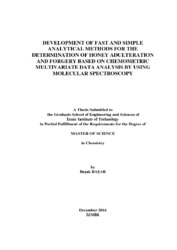Please use this identifier to cite or link to this item:
https://hdl.handle.net/11147/5741| Title: | Development of Fast and Simple Analytical Methods for the Determination of Honey Adulteration and Forgery Based on Chemometric Multivariate Data Analysis by Using Molecular Spectroscopy | Other Titles: | Baldaki Sahteciliğin ve Tağşişin Belirlenmesi için Kemometrik Veri Analizine Dayalı Basit ve Hızlı Moleküler Spektroskopik Metotların Geliştirilmesil | Authors: | Başar, Başak | Advisors: | Özdemir, Durmuş | Keywords: | Honey Honey adulteration Honey forgery Fourier transform infrared spectroscopy Molecular spectroscopy |
Publisher: | Izmir Institute of Technology | Source: | Başar, B. (2016). Development of fast and simple analytical methods for the determination of honey adulteration and forgery based on chemometric multivariate data analysis by using molecular spectroscopy. Unpublished master's thesis, İzmir Institute of Technology, İzmir, Turkey | Abstract: | Honey is one of the most valuable and expensive nutrition due to its health effects on human body. In recent years, honey adulteration has become an important problem and is a subject of many publications. There exists various analytical methods for determination of honey adulteration with 13C/12C isotope ratio mass spectrometry (IR-MS) being the most common. However, one of the recent studies indicates that different honey types depending on geographical and botanical origin may have significantly different 13C/12C isotope ratios rendering this method questionable. Thus, development of an analytical method for qualitative and quantitative determination of forgery and adulteration of honey without tedious and complicated sample preparation while being relatively simple and fast new analytical methods became a must. In this study, Fourier Transform Infrared spectroscopy coupled with Attenuated Total Reflectance and Fourier Transform Near Infrared spectroscopy based chemometrics multivariate calibration models were developed for the quantitative determination of honey adulteration. To simulate adulteration scenarios, artificially adulterated honey samples were prepared by adding beet sugar, corn syrup, glucose and sucrose with various concentrations to pure honey samples. Two different multivariate calibration methods namely Genetic Inverse Least Squares and Partial Least Squares were used and the applicability of these methods have been evaluated with an independent validations and test set composed of FTIR spectra of more than 100 pure honey samples along with the adulterated samples. Standard error of cross validation and standard error of prediction values for honey content of the samples were found 2.52% and 2.19% (w/w %), respectively. Bal mali değeri yüksek ve insan sağlığı üzerinde önemli etkileri olan bir besindir. Son yıllarda, bazı üreticiler tarafından kar oranını yükseltmek amacı ile en çok tağşişe maruz kalan besinlerden de biri haline gelen bal ile ilgili çeşitli analitik çalışmalar yaygın olarak yürütülmektedir. Söz konusu bu sahteciliklerde yaygın olarak mısır şurubu ve pancar şekeri gibi yapay tatlandırıcılar kullanılmakla beraber, kullanılan analitik yöntemlerle tağşişi nitel ve nicel olarak belirlemek mümkün hale getirilmektedir. Bu analitik yöntemlerden, izotop oranı kütle spektrometresi (IR-MS) yaygın olarak kullanılmakta ve bu yöntemde 13C/12C oranı baz alınmaktadır. Ancak son dönemlerdeki çalışmalara göre farklı coğrafik ve botanik orijinlere sahip saf bal örneklerinin de birbirinden farklı 13C/12C izotop oranlarına sahip olabildiği, dolayısıyla kantitatif olarak tağşiş eden miktarı tespitinin oldukça zor olduğu vurgulanmıştır. Bu sebeple nicel ve nitel olarak tağşişli bal örneklerini tespit edebilmek amacı ile hızlı ve kolay uygulanabilir analitik yöntemler geliştirilmesi gerektiği sonucuna varılmıştır. Bu çalışmada, tağşişli bal örneklerinin miktarsal tayini için Fourier dönüşümlü kızılötesi spektroskopisi ve Yakın kızılötesi spektroskopisi kullanılarak alınan spektral verilere kemometrik çok değişkenli kalibrasyon metotları uygulanarak yeni bir analitik metot geliştirilmesi hedeflenmiştir. Çalışmada, pancar şekeri, mısır şurubu, glikoz ve sakkaroz saflığı bozan tatlandırıcılar olarak kullanılmış ve farklı veri setlerinde kullanılan bu maddelerle çeşitli tağşiş senaryoları hazırlanmıştır. Genetik algoritma tabanlı ters en küçük kareler ve kısmi en küçük kareler yöntemi kullanılarak çok değişkenli kalibrasyon modelleri oluşturulmuş ve bu modeller üretici ve marketlerden temin edilen 100 adet saf bal örneği ile test edilmiştir. Bal bileşenine ait kalibrasyon ve validasyon setlerine ait hata değerleri %2.52 ve %2.19 aralığında tanımlanmıştır. |
Description: | Thesis (Master)--İzmir Institute of Technology, Chemistry, İzmir, 2016 Full text release delayed at author's request until 2020.01.24 Includes bibliographical references (leaves: 103-105) Text in English; Abstract: Turkish and English xiii, 105 leaves |
URI: | http://hdl.handle.net/11147/5741 |
| Appears in Collections: | Master Degree / Yüksek Lisans Tezleri |
Files in This Item:
| File | Description | Size | Format | |
|---|---|---|---|---|
| T001541.pdf | MasterThesis | 35.45 MB | Adobe PDF |  View/Open |
CORE Recommender
Page view(s)
220
checked on Mar 31, 2025
Download(s)
152
checked on Mar 31, 2025
Google ScholarTM
Check
Items in GCRIS Repository are protected by copyright, with all rights reserved, unless otherwise indicated.